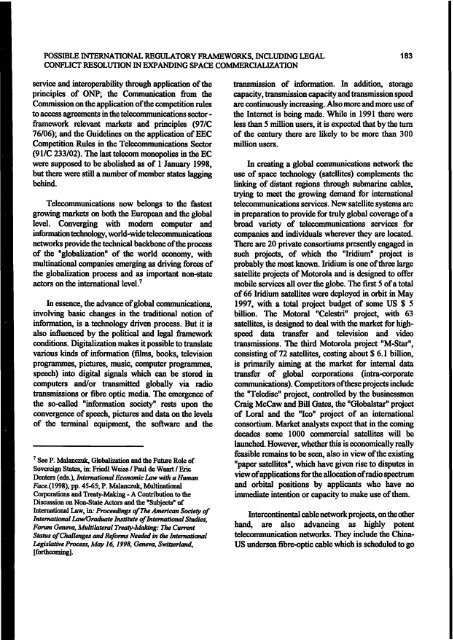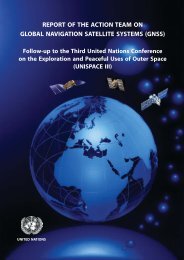Proceedings of the Workshop - United Nations Office for Outer ...
Proceedings of the Workshop - United Nations Office for Outer ...
Proceedings of the Workshop - United Nations Office for Outer ...
- No tags were found...
You also want an ePaper? Increase the reach of your titles
YUMPU automatically turns print PDFs into web optimized ePapers that Google loves.
POSSIBLE INTERNATIONAL REGULATORY FRAMEWORKS, INCLUDING LEGAL 183CONFLICT RESOLUTION IN EXPANDING SPACE COMMERCIALIZATIONservice and interoperability through application <strong>of</strong> <strong>the</strong>principles o f ONP; <strong>the</strong> Communication from <strong>the</strong>Commission on <strong>the</strong> application o f <strong>the</strong> competition rulesto access agreements in <strong>the</strong> telecommunications sector -framework relevant markets and principles (97/C76/06); and <strong>the</strong> Guidelines on <strong>the</strong> application <strong>of</strong> EECCompetition Rules in <strong>the</strong> Telecommunications Sector(91/C 233/02). The last telecom monopolies in <strong>the</strong> ECwere supposed to be abolished as <strong>of</strong> 1 January 1998,but <strong>the</strong>re were still a number o f member states laggingbehind.Telecommunications now belongs to <strong>the</strong> fastestgrowing markets on both <strong>the</strong> European and <strong>the</strong> globallevel. Converging with modem computer andin<strong>for</strong>mation technology, world-wide telecommunicationsnetworks provide <strong>the</strong> technical backbone o f <strong>the</strong> process<strong>of</strong> <strong>the</strong> "globalization" o f <strong>the</strong> world economy, withmultinational companies emerging as driving <strong>for</strong>ces <strong>of</strong><strong>the</strong> globalization process and as important non-stateactors on <strong>the</strong> international level.7In essence, <strong>the</strong> advance <strong>of</strong> global communications,involving basic changes in <strong>the</strong> traditional notion <strong>of</strong>in<strong>for</strong>mation, is a technology driven process. But it isalso influenced by <strong>the</strong> political and legal frameworkconditions. Digitalization makes it possible to translatevarious kinds <strong>of</strong> in<strong>for</strong>mation (films, books, televisionprogrammes, pictures, music, computer programmes,speech) into digital signals which can be stored incomputers and/or transmitted globally via radiotransmissions or fibre optic media. The emergence <strong>of</strong><strong>the</strong> so-called "in<strong>for</strong>mation society" rests upon <strong>the</strong>convergence <strong>of</strong> speech, pictures and data on <strong>the</strong> levels<strong>of</strong> <strong>the</strong> terminal equipment, <strong>the</strong> s<strong>of</strong>tware and <strong>the</strong>7 See P. Malanczuk, Globalization and <strong>the</strong> Future Role <strong>of</strong>Sovereign States, in: Friedl W eiss / Paul de W aart / EricDenters (eds.), International Economic Law with a HumanFace.(1998), pp. 45-63; P. Malanczuk, M ultinationalCorporations and Treaty-Making - A Contribution to <strong>the</strong>Discussion on Non-State Actors and <strong>the</strong> "Subjects" <strong>of</strong>International Law, in: <strong>Proceedings</strong> o f The American Society <strong>of</strong>International Law/Graduate Institute o f International Studies,Forum Geneva, Multilateral Treaty-Making: The CurrentStatus o f Challenges and Re<strong>for</strong>ms Needed in <strong>the</strong> InternationalLegislative Process, May 16,1998, Geneva, Switzerland,[<strong>for</strong>thcoming].transmission o f in<strong>for</strong>mation. In addition, storagecapacity, transmission capacity and transmission speedare continuously increasing. Also more and more use <strong>of</strong><strong>the</strong> Internet is being made. While in 1991 <strong>the</strong>re wereless than 5 million users, it is expected that by <strong>the</strong> turno f <strong>the</strong> century <strong>the</strong>re are likely to be more than 300million users.In creating a global communications network <strong>the</strong>use o f space technology (satellites) complements <strong>the</strong>linking o f distant regions through submarine cables,trying to meet <strong>the</strong> growing demand <strong>for</strong> internationaltelecommunications services. New satellite systems arein preparation to provide <strong>for</strong> truly global coverage <strong>of</strong> abroad variety o f telecommunications services <strong>for</strong>companies and individuals wherever <strong>the</strong>y are located.There are 20 private consortiums presently engaged insuch projects, o f which <strong>the</strong> "Iridium" project isprobably <strong>the</strong> most known. Iridium is one <strong>of</strong> three largesatellite projects <strong>of</strong> Motorola and is designed to <strong>of</strong>fermobile services all over <strong>the</strong> globe. The first 5 <strong>of</strong> a totalo f 66 Iridium satellites were deployed in orbit in May1997, with a total project budget o f some US $ 5billion. The Motoral "Celestri" project, with 63satellites, is designed to deal with <strong>the</strong> market <strong>for</strong> highspeeddata transfer and television and videotransmissions. The third Motorola project "M-Star",consisting <strong>of</strong> 72 satellites, costing about $ 6.1 billion,is primarily aiming at <strong>the</strong> market <strong>for</strong> internal datatransfer <strong>of</strong> global corporations (intra-corporatecommunications). Competitors o f <strong>the</strong>se projects include<strong>the</strong> "Teledisc" project, controlled by <strong>the</strong> businessmenCraig McCaw and Bill Gates, <strong>the</strong> "Globalstar" projecto f Loral and <strong>the</strong> "Ico" project o f an internationalconsortium. Market analysts expect that in <strong>the</strong> comingdecades some 1000 commercial satellites will belaunched. However, whe<strong>the</strong>r this is economically reallyfeasible remains to be seen, also in view <strong>of</strong> <strong>the</strong> existing"paper satellites", which have given rise to disputes inview o f applications <strong>for</strong> <strong>the</strong> allocation o f radio spectrumand orbital positions by applicants who have noimmediate intention or capacity to make use <strong>of</strong> <strong>the</strong>m.Intercontinental cable network projects, on <strong>the</strong> o<strong>the</strong>rhand, are also advancing as highly potenttelecommunication networks. They include <strong>the</strong> China-US undersea fibre-optic cable which is scheduled to go
















